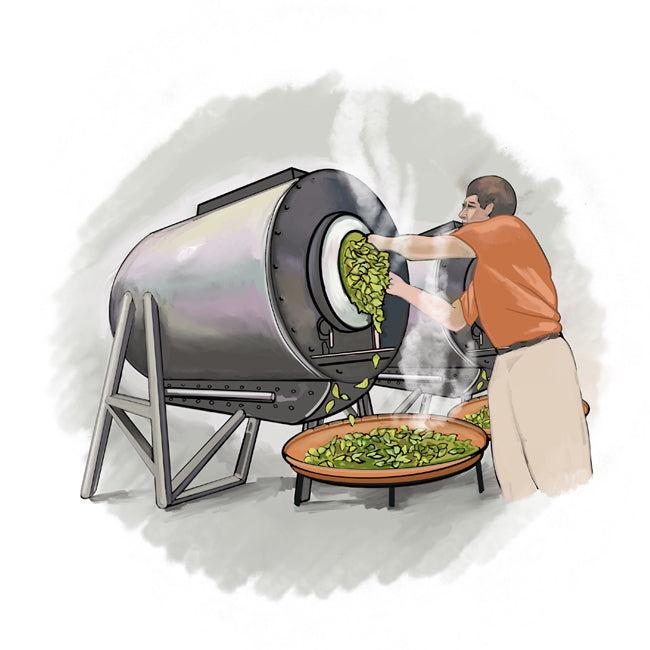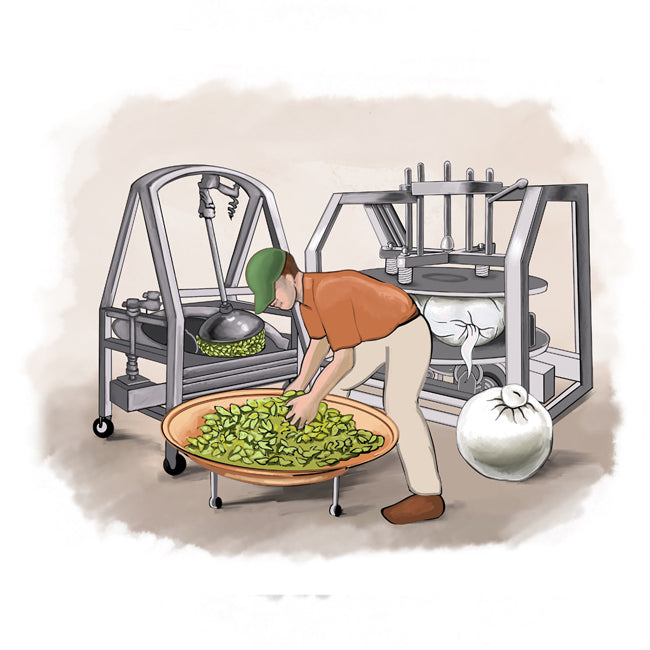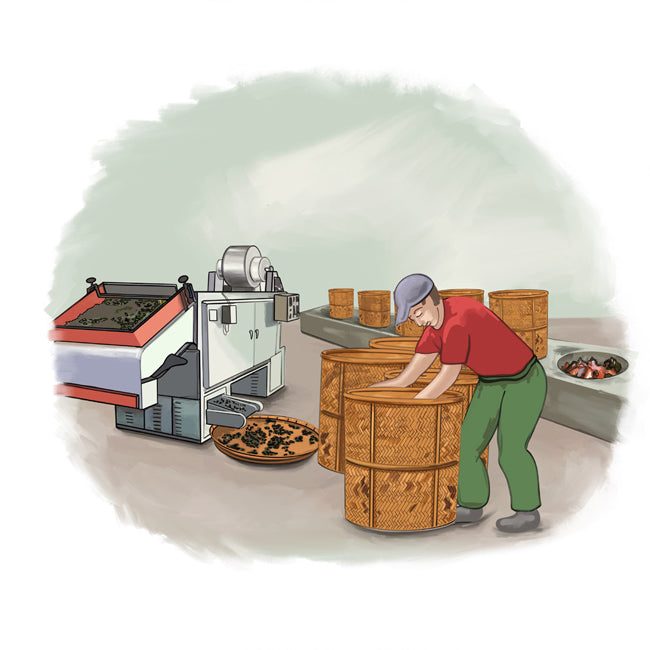
What is Milk Oolong
Milk Oolong is a distinctive type of Taiwanese tea cultivar known for its creamy flavor and texture. Oolong tea comes from the camellia sinensis plant, which falls in between green and black tea in oxidation and may display characteristics of both.
Milk oolong is typically lightly oxidized and roasted, which helps retain the delicate floral aroma and creamy flavor.
When we refer to milk oolong, we’re talking about Taiwanese tea from the Jin Xuan (pronounced jin shuan) cultivar. You may see milk oolong referred to as:
- Silk Oolong
- Jin Xuan
- Nai Xiang
- Golden Lily
How is Milk Oolong Made?
Grown at mid to high altitude in the mountains of Taiwan, the tea leaves are harvested in spring and autumn. After plucking the tea goes through a series of steps:
- Withering: The leaves are spread out on mats and allowed to wither in order to remove excess moisture. It takes great skill to ensure all the leaves are withered evenly.
- Oxidation: The tea leaves are tossed to gently bruise them, exposing their inner cells to the air. This causes the leaves to oxidize. Leaves are allowed to oxidize in a temperature-controlled environment until they achieve the desired flavors and aroma. Heat is then applied to halt the oxidation process.
- Twisting: The leaves are manipulated by machine or hand, twisting them into a semi-balled style shape.
- Sorting: The leaves are sorted, and broken bits are removed.
- Roasting: A final firing is given to the leaves to remove excess moisture and coax out more delicate flavors. The result should be a tea with a floral and sweet cream aroma, milky flavor, and a beautifully silky texture. As we noted, milk or other dairy products should not be added to any step of processing this tea. If a vendor mentions added milk flavors, this is not an authentic Jin Xuan Taiwanese milk oolong.




Milk Oolong Flavor Notes
It is known for its naturally light and creamy aftertaste with a rich body, hence the name. It is a very popular tea due to its appealing flavor and aroma. It does not, however, mean the tea was processed with milk in any way. Dairy should be in the name only and not in the ingredients. If you are at a bubble tea café and see Taiwan Milk Oolong, that is a very different thing.
Want to give milk oolong a try? We offer a few contrasting expressions of the cultivar:
The Origins of Milk Oolong
When we look at the long history of tea, Jin Xuan, a cultivar of the camellia sinensis plant, is a relative newcomer. The hybrid cultivar was first created in Taiwan during the 1980s at the Taiwanese Tea Research and Extension Station (TRES).
It is also referred to as TRES #12 and became known as milk oolong due to the creamy flavor and aroma. Quickly becoming popular for its flavor and texture Jin Xuan is one of the most commonly grown cultivars in Taiwan.
What does Milk Oolong look like?
Milk oolong has a distinctive semi-balled shape due to the traditional method of rolling during processing most commonly used in Taiwan. It has a lush green appearance as is mostly lightly oxidized, closer in color to a green tea.
Oxidation is halted to prevent it from becoming darker in color and flavor. When steeped, the twisted leaves slowly unfurl. Because of the shape and processing of this tea, it can be steeped many times.



Milk Oolong Misconceptions
Understanding the Name
Just because a tea is called ‘milk oolong’ or 'milky oolong, or even labelled as Jin Xuan, it doesn’t mean it’s from the Jin Xuan cultivar. Due to the popularity of this tea and its limited supply, milk oolong teas may be created from lower-grade green oolongs that have a milk flavoring added. It’s important to be very aware of the product you are purchasing. Quality and vendor transparency is key.
What's Real and What Isn't
Real Taiwanese Jin Xuan oolongs are not produced using any dairy products. If you see the word ‘milk’ used in any of the processing or growing steps for this tea, a red flag should immediately start waving in your head. Anything that is ‘scented’ also means you don’t have the real thing. Knowing where your tea was grown (preferably on a Taiwanese mountain) and how it was processed will help you identify its authenticity.
Tasting the Difference
So, you think you bought a real milk oolong but you’re still not sure? The real proof of a milk oolong is in the taste. If you sip a milk oolong that is overwhelmingly creamy in aroma or flavor, it’s most likely artificially flavored. A natural milk oolong has a balanced, delicate flavor. Another telltale sign is when you steep the tea multiple times in a small vessel such as a gaiwan. If the creamy texture and flavor falls flat after the first steep or two, it was most likely artificially flavored. A real milk oolong will retain its delicate creamy flavor and texture for multiple infusions.
Health Benefits and Caffeine Content
Antioxidants and Nutrients
Oolong tea has a high concentration of antioxidants. It’s also known to contain minerals, vitamins, and amino acids. It may even help lower cholesterol and boost your metabolism. For a more details, feel free to check out our dedicated post on Oolong Tea Health Benefits.
Caffeine in Milk Oolong
Milk oolong contains caffeine as it is from the camellia sinensis plant. The plant naturally creates caffeine to ward off hungry pests. If you want to learn more specific information on caffeine levels in tea, please refer to our Tea and Caffeine post.
Bonavita Electric Kettle
With temperature settings and a great pour, this is our electric kettle of choice.
Shop NowHow to brew Milk Oolong
Brewing Hot
- Milk Oolong 6 grams (about a heaping teaspoon)
- Water 237 ml, heated to 212°F (boiling)
Place the Milk Oolong leaves in your brewing vessel. Pour the boiling water over the leaves and steep for 1-2 minutes. This tea can be steeped multiple times and should retain its milky aroma and textures throughout the steeps. The semi-balled shaped leaves should fully unfurl after multiple steeps. You can use a gaiwan or a teapot for this tea.
Brewing Iced
- Milk Oolong 8 grams
- Water .75 liters
Although milk oolong is rolled into a balled shape we prefer cold brewing the tea, since it's transformed into a sweet and delicious flavor. Check out our cold brew tea brewing guide for step-by-step instructions.
Milk Oolong FAQ's
Why is it called Milk Oolong?
It gets its name from its naturally creamy and buttery taste. The unique flavor profile is not the result of added dairy products but a characteristic inherent to the tea leaves. The term "milk" in its name refers to this creamy quality, reminiscent of milk, rather than any actual milk content.
Is it OK to put milk in Oolong Tea?
While traditionally Oolong tea is enjoyed without milk, there's no hard and fast rule against adding milk. It's a matter of personal preference. However, be aware that milk can overshadow Oolong's delicate flavors, especially in lighter varieties. In darker Oolongs, it could add creaminess but may alter the original taste. If you enjoy the creamy texture that milk adds to tea, feel free to experiment.
